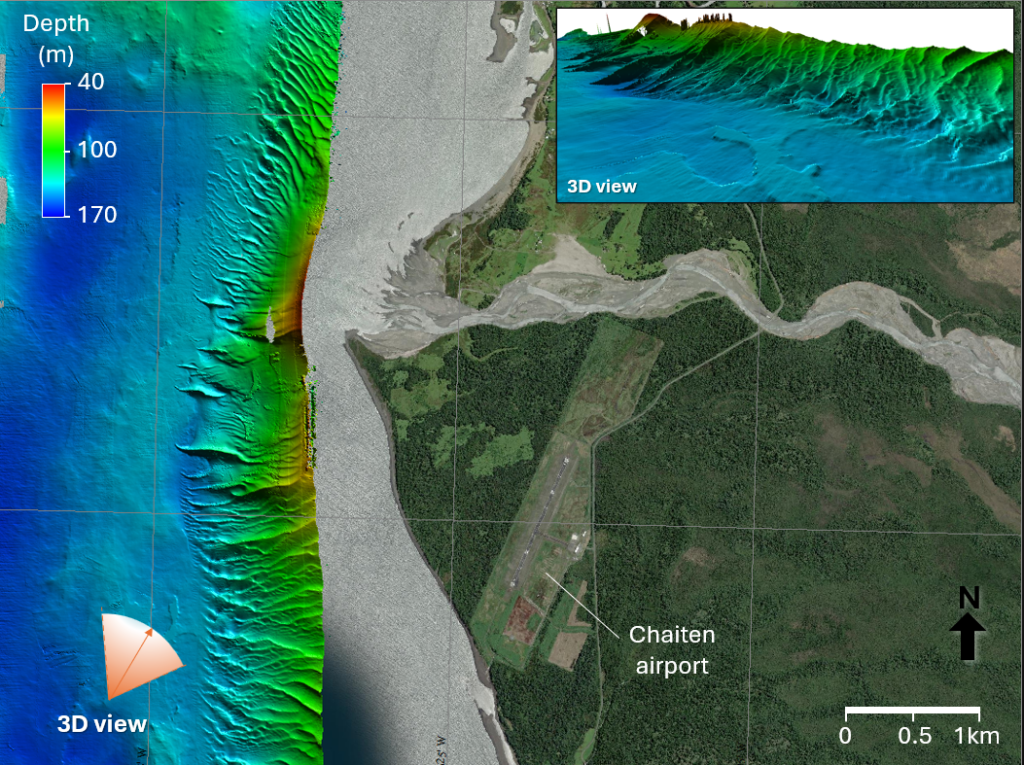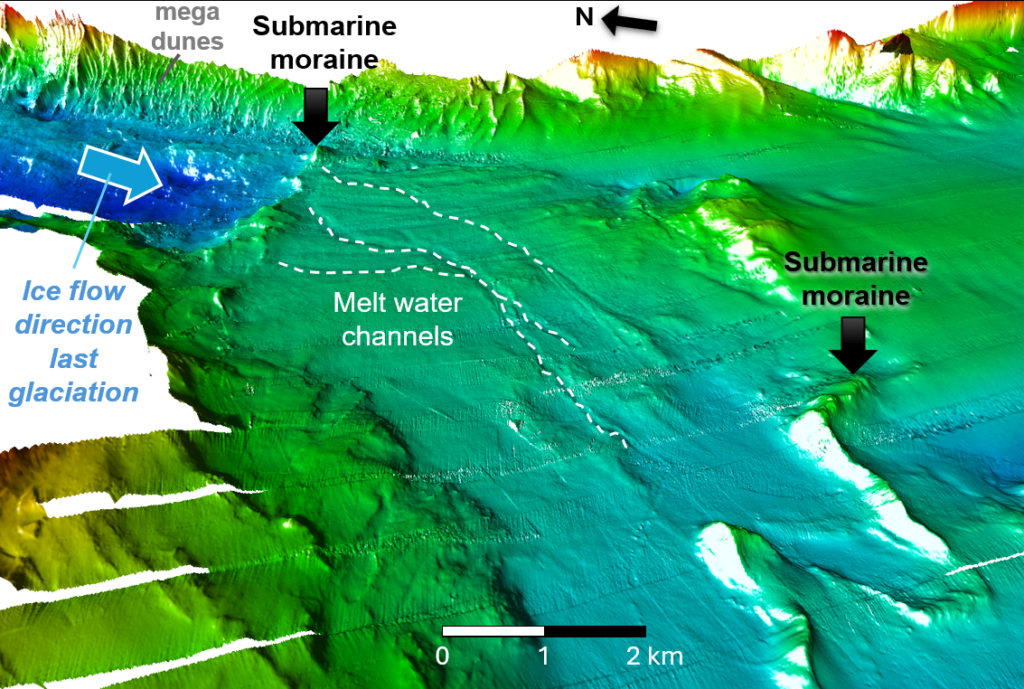Researchers found a fossilized seascape while studying the impact of a volcanic eruption.

This May 26, 2008 photo shows the Chaitén lava dome with lava spilling out the left side and a giant plume of
ash blasting into the sky. The eruption lasted several months and blanketed surrounding farmland in ash.
Credit: United States Geological Survey
On May 2, 2008, the Chaitén volcano in Chile awoke with unexpected fury after more than 9,000 years of dormancy. The eruption blasted rocks and ash a dozen miles into the air, and then heavy rainfall swept the fallen debris up in immense mudflows. A river of rubble carved a destructive path through the nearby town of Chaitén before surging into the sea. The town, practically split in two by the torrent that cut through its middle, was evacuated as ash blanketed over 200,000 square kilometers of surrounding land.
While the terrestrial aftermath was plain to see, captured by both the local media and satellites, the impact on the sea was unknown.

The eruption released over 750 billion liters of lava—enough to fill more than 300,000 Olympic-sized swimming pools—mainly in the form of rock fragments. The debris flowed through rivers into the Northern Patagonian Sea, just six miles away.
An international team of scientists set sail on the Schmidt Ocean Institute’s Falkor (too) research vessel in September to trace the volcanic ash’s flow and assess its effects. Along the way, they found an underwater valley carved out by ancient glaciers. It’s hardly been altered in the 17,000 years or so since those glaciers retreated.

They wanted to explore how volcanoes impact the sea, its inhabitants, and underwater infrastructure.
“Our observations will allow us to explore how active volcanoes affect marine environments and infrastructure, ranging from fisheries to communication cables,” the expedition’s chief scientist, Sebastian Watt, an associate professor in Earth sciences at the University of Birmingham, said in a press release. The town of Chaitén is very rural, and the area itself lacks submarine cables, but the team’s work could help assess whether volcanic activity might damage those cables at other locations across the globe.
Because of how they form, volcanoes are nearly always found in or near the ocean, yet scientists have hardly studied how eruptions affect marine ecosystems. “A range of hazards can impact communities in the aftermath of volcanic eruptions,” Watt said, “and the information we gather from studying the 2008 Chaitén eruption is relevant for coastal and island volcanoes globally.”

A remotely operated vehicle (ROV) called SuBastian served as the team’s underwater eyes. Fitted with a suite of lights, cameras, and sensors, the ROV explored the areas where volcanic debris had washed into the ocean.
“We used the ROV SuBastian to gather samples that would otherwise be impossible to obtain,” said Rodrigo Fernández, an assistant professor at the Universidad de Chile, who co-led the expedition. “And the ability to see the sampling sites with our own eyes and select the very best targets is a game changer. We usually sample the seafloor blind, selecting targets based on geophysics data acquired from the vessel and then deploying equipment hundreds or thousands of meters down.”
The team collected samples that contain both sediment and shells, which they’ll analyze to help determine the samples’ ages and to study microbial and geochemical changes. Comparing lower layers (from before the eruption) with higher ones will let them see how the eruption affected the marine ecosystem.

The ROV’s lights in the ocean shine like a candle in the night, casting an eerie glow on its immediate surroundings but unable to provide a big-picture view. For that, the team used sonar instruments on the ship to make a high-resolution 3D map of the seafloor.

That map revealed underwater giants—towering “mega-dunes” made of volcanic ash. The dunes are an imprint that hints at the forces that sculpt the seafloor, allowing scientists to trace the transport of volcanic material after it was swept into the sea. The team mapped over 1,000 square miles, collected data on what lies more than six stories beneath the seafloor, and found ash more than 15 miles from the volcano.

The ROV was equipped with a vibrating coring device, a straw-like instrument that gathered sediment samples by plunging into the seafloor. The layers of sediment collected in the core samples preserve evidence of the area’s past geological and biological activity.
Perhaps counterintuitively, sediment layers are more likely to remain intact on the seafloor than on land, so they can provide a better record of the region’s history. The seafloor is a more stable, oxygen-poor environment, reducing erosion and decomposition (two reasons scientists find far more fossils of marine creatures than land dwellers) and preserving finer details.

Samples from different areas vary dramatically in time coverage, going back only to 2008 for some and back potentially more than 15,000 years for others due to wildly different sedimentation rates. Scientists will use techniques like radiocarbon dating to determine the ages of sediment layers in the core samples.

Microscopic analysis of the sediment cores will also help the team analyze the way the eruption affected marine creatures and the chemistry of the seafloor.
“There’s a wide variety of life and sediment types found at the different sites we surveyed,” said Alastair Hodgetts, a physical volcanologist and geologist at the University of Edinburgh, who participated in the expedition. “The oldest place we visited—an area scarred by ancient glacier movement—is a fossilized seascape that was completely unexpected.”

This feature, too, tells scientists about the way the water moves. Currents flowing over an area that was eroded long ago by a glacier sweep sediment away, keeping the ancient terrain visible.
“I’m very interested in analyzing seismic data and correlating it with the layers of sediment in the core samples to create a timeline of geological events in the area,” said Giulia Matilde Ferrante, a geophysicist at Italy’s National Institute of Oceanography and Applied Geophysics, who co-led the expedition. “Reconstructing the past in this way will help us better understand the sediment history and landscape changes in the region.”

The team has already gathered measurements of the amount of sediment the eruption delivered to the sea. Now they’ll work to determine whether older layers of sediment record earlier, unknown events similar to the 2008 eruption.
“Better understanding past volcanic events, revealing things like how far away an eruption reached, and how common, severe, and predictable eruptions are, will help to plan for future events and reduce the impacts they have on local communities,” Watt said.
Ashley writes about space for a contractor for NASA's Goddard Space Flight Center by day and freelances as an environmental writer. She holds master's degrees in space studies from The University of North Dakota and science writing from The Johns Hopkins University. She writes most of her articles with a baby on her lap.
Hope you enjoyed this news post.
Thank you for appreciating my time and effort posting news every day for many years.
2023: Over 5,800 news posts | 2024 (till end of November): 5,298 news posts
RIP Matrix | Farewell my friend ![]()


3175x175(CURRENT).thumb.jpg.b05acc060982b36f5891ba728e6d953c.jpg)
Recommended Comments
There are no comments to display.
Join the conversation
You can post now and register later. If you have an account, sign in now to post with your account.
Note: Your post will require moderator approval before it will be visible.